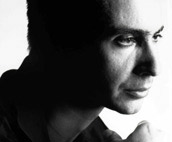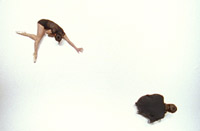Opening
Program  Program
I Program
I  Program
II Program
II  Program
III Program
III  Program
IV Program
IV  Program
V Program
V  Program
VI Program
VI  Program
VII Program
VII  Program
VIII Program
VIII  Program
IX Program
IX  Program
X Program
X  Program
XI Program
XI  Russian
Dance Film Competition Russian
Dance Film Competition  Closing Program
Closing Program

Program
III: Dance Film Choreographer in Focus: Édouard Lock

Photo
by Jean-Francois Berube |
Édouard Lock's
career as a choreographer has spanned 30 years during which he
has created works for some of the worlds leading dance companies,
garnering international acclaim for originality, vision, and structure.
In 2002, he was awarded the Prix Denise Pelletier, Québec's
highest cultural award, and in 2003 received the Benois de la
Danse for André Auria, which he choreographed for the Paris
Opera Ballet. His film adaptation of Amelia premiered at the 2003
Montréal International Festival of New Cinema and New Media.
Since its formation 23 years ago, La La La Human Steps has produced
experimental works that combine balletic structures with choreographic,
musical, and cinematic elements to create a sense of perceptual
distortion and renewal. Its varied collaborators have included
the Paris Opera and Frank Zappa.
“Amelia”
60min,
2003, Canada
Director/Choreographer: Édouard
Lock
Dancers: La La La Human Steps
 Photo
by Édouard
Lock
Photo
by Édouard
Lock |
An acclaimed
Canadian choreographer Édouard
Lock creates an interpretation of his own modern
ballet Amelia.
The exquisite performance and grace of his dance troupe La
La La Human Steps is brilliantly complemented by the striking
cinematography and editing of André Turpin. It appears
that Amelia is
fully realized on screen rather than on stage. With transcendent
music by David Lang and lyrics by Lou Reed and sets designed
by Édouard Lock.
Since
its premier in Montreal October 2003, Amelia has
been screened at festivals around the world including the
US, Australia, Canada, Finland, France, Germany, Israel, Norway
and Spain.
Director's
Statement:
"My
intention was to create a film on dance without narrative
or other extraneous story telling devices. The choreographers
were taken from the stage work Amelia and the camera was in
turn precisely choreographed to each of the dances. The visual
environment of the stage work was completely altered for the
film version. The premise was to create a set of visual tableau,
that would seamlessly flow one into the other in one minimalist
environment, which would alter only through the use of lighting
and camera angles. I conceived the environment as one uniform
box of wood with rounded wall to floor joints composed of
maple floor planks. The planks for me were like taking the
stage floor and wrapping it around the dancer.The camera had
at times a 360-degree travel, which sometimes needed additional
choreography to get the dancers in and out of frame at the
right time.
The film was shot in super 16. I edited the film and then
the edit was conformed to high definition for post production
and color work. The edit is comprised almost entirely of cuts.
I was really happy to work with director of photography André
Turpin. I thought he lit beautifully, and there was a real
sense of experimentation on set trying to devise ways of executing
some of the shots and camera movements. His experience and
spirit were greatly appreciated.
I've often worked with film in my theatrical productions.
This is the first film I've directed a film that is intended
to be seen outside of a theatrical setting. I think a theatre
audience shifts their point of view continuously in connection
to what they wish to see, even though they remain in their
seats while they do so. Though their physical position remains
static, they alter their virtual point of view dynamically
in response to their observations and level of involvement.
In some ways this film reflects this observation." -
Édouard Lock
Opening
Program  Program I
Program I  Program
II Program
II  Program
III Program
III  Program
IV Program
IV  Program
V Program
V  Program
VI Program
VI  Program
VII
Program
VII  Program
VIII Program
VIII  Program
IX Program
IX  Program
X Program
X  Program
XI Program
XI  Russian
Dance Film Competition Russian
Dance Film Competition  Closing Program
Closing Program
© Kinodance–Russia, 2004
akovgan@kinodance.com
|
|

